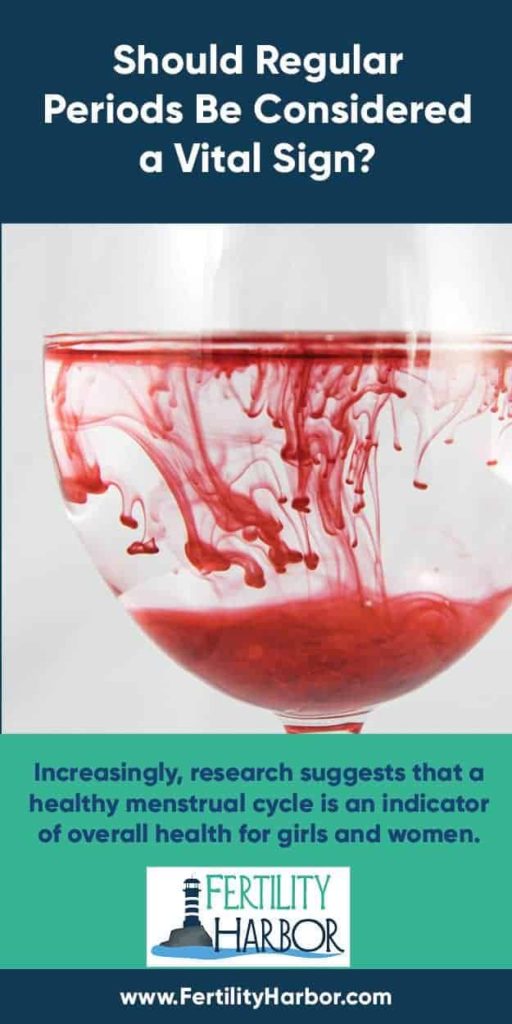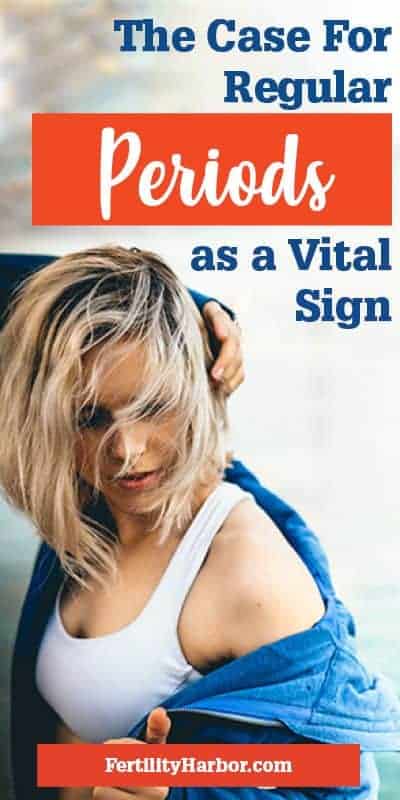This post was reviewed for medical accuracy by Rosalie Gunson, a Certified Registered Nurse Practitioner specializing in fertility care.
Did you know that there’s an effort to get healthy menstrual cycles recognized as a fifth vital sign, especially for adolescent girls?
Increasingly, research suggests that a healthy menstrual cycle is an indicator of overall health for girls and women. Even if you have no desire to become pregnant, it is important for your reproductive system to function normally.
But let’s back up for a minute. What are vital signs, anyway?
The Traditional Vital Signs
Pretty much any time you go to the doctor, he or she will “check your vitals.” These measurements help describe your health status at that point in time, as well as over multiple visits.
If you end up in the emergency room, the doctors will check your vitals as a way of quickly assessing how you’re doing. If you have a chronic condition, your doctor can track your vitals over time to see what’s working and what isn’t.
These are the main vital signs:
- Pulse (Heart Rate)
Your pulse is the number of times your heart beats in a minute. This is usually measured by your doctor putting three fingers on your wrist and counting heartbeats, or with a stethoscope over the heart. A healthy adult has a pulse of 60-100 beats per minute. - Blood Pressure
Blood pressure is the pressure of the blood as it is forced against the walls of the arteries. This is usually measured with a blood pressure cuff on your arm. A healthy adult’s blood pressure should be 120/80 or less. High blood pressure is a major cause of heart attacks and strokes. - Body Temperature
This is usually measured with a thermometer in your mouth or a gizmo (pulse oximeter) on your finger. A healthy adult’s temperature should be between 97.8 and 99 degrees F. A high temperature (fever) can indicate infection or inflammation.Side note about fevers: A high fever during fertility treatment can lead to a cancelled cycle. For more info, see Should You Do a FET If You Are Sick? and Why Would a Cycle of Fertility Treatment Get Cancelled? - Breathing (Respiratory Rate)
The respiratory rate is the number of breaths you take in a minute. A healthy adult’s respiratory rate at rest is 12 to 20 breaths per minute. - Oxygen saturation
Oxygen saturation is sometimes included as a vital sign. It measures the extent that hemoglobin is saturated with oxygen in your blood. It is usually measured with a gizmo (pulse oximeter) that sits on your finger, or with a blood test.Oxygen saturation is more often measured in the hospital or at certain specialists than at your primary care doctor’s office. Healthy oxygen saturation is between 95% and 100%.
Is Pain a Vital Sign?
Some people consider pain level a vital sign, but that has fallen out of favor recently because it’s so subjective. What is 10/10 pain to one person may be barely 3/10 to another. There is also some concern that using pain level as a vital sign can increase prescription opioid abuse.
Is Weight (or BMI) a Vital Sign?
No! Your weight does have implications for your health and for dosing medications, but in general it is not considered a vital sign.
Concerned about the effect your weight may have on your fertility, or struggling to have doctors take your infertility problems seriously because of your weight? TTC With a High BMI: How to Get the Quality Care You Deserve has more info.
Menstrual Cycles as a Vital Sign
As we’ve seen, vital signs are useful for assessing someone’s health status now and over time. They are generally quantifiable and measurable using equipment that any doctor’s office would have.
So what about periods? Obviously, if you’re rushed to the hospital in an emergency, nobody is going to ask you when you last had your period. The point of the movement to have menstrual health considered a vital sign is to recognize that women of reproductive age can’t be truly healthy unless their menstrual cycles are healthy.
In December 2015, the American College of Obstetrics and Gynecology’s Committee on Adolescent Health Care issued an opinion called Menstruation in Girls and Adolescents: Using the Menstrual Cycle as a Vital Sign. This opinion was endorsed by the American Academy of Pediatrics. In this opinion, the ACOG made the following recommendations:
- “Clinicians should educate girls and their caretakers (eg, parents or guardians) about what to expect of a first menstrual period and the range for normal cycle length of subsequent menses.”
- “Once girls begin menstruating, clinicians should ask at every preventive care or comprehensive visit for the patient’s first day of her last menstrual period and the pattern of menses.”
- “Identification of abnormal menstrual patterns in adolescence may improve early identification of potential health concerns for adulthood.”
- “It is important for clinicians to have an understanding of the menstrual patterns of adolescent girls, the ability to differentiate between normal and abnormal menstruation, and the skill to know how to evaluate the adolescent girl patient.”
4 reasons it makes sense to pay attention to menstrual cycles as an indicator of the overall wellbeing of girls and women
1) Girls and women should understand what a normal cycle looks like.
At home or in school, girls are often handed pads and tampons, but they are not usually taught what a healthy period means in terms of flow, frequency, pain, etc. The actual details of periods are not discussed.
For example, girls may not be told that periods are not supposed to be painful and you shouldn’t have to change a tampon every hour.
To make matters worse, we’re so weirded out by periods that misinformation and rumor fills in the gaps. We teach girls that a normal function of their bodies is gross and embarrassing and then we wonder why they sometimes go years without realizing that they have a health issue!
2) A focus on menstrual health might lead providers to catch serious or long-term issues earlier.
I got my period a few times a year until I went on birth control pills at 18. Throughout middle and high school I basically assumed that I was young and my body would straighten itself out eventually. Besides, who wants to get their period more often? I had never heard of PCOS and certainly never suspected I had a chronic health condition.
I wasn’t diagnosed with PCOS until I finally went off the Pill more than a decade later. I’m sure thousands of women are in that same boat! Wouldn’t it be awesome if medical professionals flagged issues like PCOS much earlier, because they were taking menstrual health seriously?
Doctors do often ask women when their last period was, but it’s not clear that they do much with that information besides record the date in the chart.
In my experience, they are much more interested in making sure young women are not having unprotected sex than making sure they are having healthy periods.
Here are just a few medical conditions that your period can alert you about:
- Very heavy periods: Uterine fibroids, endometriosis, hypothyroidism, anemia, blood disorders
(Some women are so used to heavy periods, they don’t even realize it’s unusual!) - Periods with large clots (bigger than a quarter): Fibroids, pregnancy loss
- Very painful cramps or pelvic pain: Endometriosis, ectopic pregnancy
- Absent or very infrequent periods: PCOS, hyperthyroidism, other kinds of hormonal imbalances, premature ovarian failure, athletic over-training, eating disorders
- Periods with blood that smells bad: Infections (including STDs)
- Lots of spotting between periods: Pelvic inflammatory disease, infections
3) Providers could be more knowledgeable about what can be done to regulate periods without hormonal birth control.
Girls and women who go to the doctor complaining about heavy, too frequent, or irregular periods are usually put on birth control — unless of course they are trying to get pregnant. In that case, they are usually put on Clomid or letrozole as a first step.
The problem is that there are lots of women who want their periods fixed, but don’t want to go on birth control or take fertility drugs. For instance, you may have tried the Pill but hated the side effects. Or maybe you are interested in getting pregnant as naturally as possible. (TTC Naturally After Failed IVF has some more details on that.)
Unfortunately, many traditional doctors don’t have a solution for those scenarios. They might tell you to lose weight (gee, thanks!), but that’s probably it. It may help to see a functional medicine provider who is more knowledgeable about the root causes of these issues.
4) When we are empowered with knowledge about (and pride in!) our own bodies, we can help fight for social justice for women and girls and a more sustainable future for everyone.
Basic fertility awareness is making a comeback. In some ways, it’s tied to the renewed popularity of other traditional practices like breastfeeding, baby-wearing, and organic farming. Many women are returning to the older, more natural ways of doing things.
I don’t know if you’ve noticed, but menstruation has become a hot-button feminist issue! Activists are fighting to:
- Improve access to hygiene products for girls in poverty, both here and abroad.In many cases, girls in developing nations actually stay home from school during their periods due to the lack of appropriate hygiene products. Giving them the appropriate products helps them stay in school and build a stable future for themselves. For more, see periodequity.org.
- Exempt hygiene products from state sales tax.
- Increase awareness of the health and environmental risks of tampons, and promote alternatives like the menstrual cup.
On the surface, many of these initiatives seem like they’re about pads and tampons. But the underlying purpose is to empower women to live their full lives while on their period and to take control of their reproductive health. Isn’t that what we all want?

This post was last updated in May 2020.




 I’m Jenn! Here I am with my beautiful twin boys. My pregnancy was possible thanks to fertility treatment for PCOS.
I’m Jenn! Here I am with my beautiful twin boys. My pregnancy was possible thanks to fertility treatment for PCOS.


